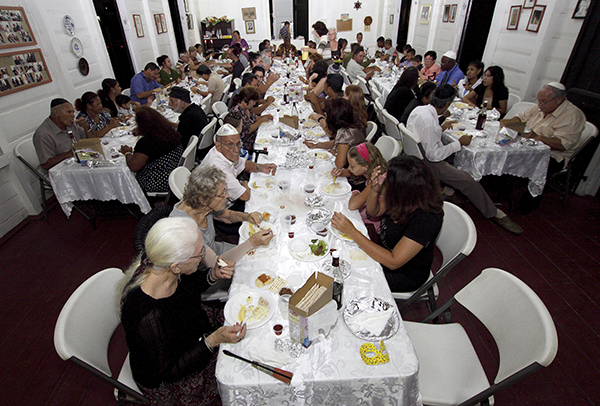Here it is, the day before Pesach.
You have pretty much finished your cooking and baking. The table is set. The wine is chilling.
You have bought multiple copies of that great new haggadah that everyone is talking about — the one with relevant readings, modern commentaries, spectacular illustrations, with a foreword written by some hipster sage that you read about once in Tabletmag.
This. Is. Going. To. Be. The. Best. Seder. Ever.
Except, you forgot:
- Uncle Harry. Harry really doesn’t care all that much about relevant haggadot — or, even, irrelevant haggadot. Harry is coming because he loves you, and your kids, and, frankly, your matzah ball soup.
- Your cousin, Moonburst. She thinks that the whole thing is a colossal waste of time. She can’t stand Jewish cooking, and couldn’t care less about that kugel recipe that your great-aunt Mima smuggled out of Romania in her shoe.
- Your niece and nephew, Lancelot (Hebrew name: Eliezer) and Hannah Maria. They never went to religious school; can’t read Hebrew; and they show up in sweaty soccer clothes, direct from practice. If you ask them, politely, to put away their IPhones for an hour, they will look at you as if you are Pharaoh himself.
- Your old college friend, Dovid Chaim Beer Ha-levi. Back at SUNY Purchase, he was Donald, and his main spiritual experience was scoring enough acid to get through the first side of “Dark Side of the Moon.” Now, he lives in Borough Park (in an apartment that his parents subsidize), studies at a yeshiva — and complains that your seder isn’t long enough, and that no one wants to hear his recently acquired insight from an obscure nineteenth century Hasidic sage whose name he cannot pronounce.
This is the unsettling little secret about Pesach that no one ever talks about.
Every year, I do a reality check about this with my colleagues.
They all say the same thing: our seders are lame. Not everyone is into it at the same level — or, at any level.
One senior colleague admitted to me: “The last truly meaningful seder I attended was about forty years ago — when I was still in rabbinical school, and one of the professors invited me over.”
Why does this happen? How did the seder become disappointing, for so many people?
The Pesach seder is the only domestic religious experience during the year in which there will be a diversity of Jews around a table, charged with not only eating — but discussing a Jewish text.
(My hunch: this is probably less true at Orthodox seders. Why? Due to the relatively homogenous nature of those communities, in which there are communal expectations, everyone will sit at the table with common knowledge levels. But, I could be wrong.)
Add to this: while Pesach continues to be one of the most-observed and beloved Jewish holidays, I wonder whether those dinners are “real” seders — complete with haggadot and prayers and songs.
I suspect that many seders are non-seders, with no haggadot.
Pesach has become the Jewish spring time Thanksgiving dinner.
My main concern is simply this: If Jews do not tell the story of our oppression and liberation, how can we understand our current situation?
And, if Jews do not tell the story of our oppression and liberation, how sensitive will we be towards other people’s oppression — and potential liberation?
Alliteration alert: Seder sans substance seems sad. Say something significant.
How can you “fix” your seder — even if you don’t go through the whole haggadah (news flash: no one ever does)? How can you bring a little extra something to your seder?
It’s all about questions. Here are some contemporary questions to ask at your seder — just to use as discussion starters (full disclosure: with links to things I have written, but Rav Google will help you find stuff as well).
- What kinds of fears and opportunities did the Tree of Life massacre raise for American Jews?
- To what extent is antisemitism a growing problem in America, and the world today?
- How should Jews respond to the growing Islamophobia in America and in the world?
- What are the Jewish responses to the immigration crisis at our borders?
- What are the Jewish responses to climate change?
- Why is racism still a thing in America?
- In what kinds of “Egypts” are women still enslaved?
- What are your hopes, concerns, and fears about the current situation in Israel?
- How the _____ did measles become the eleventh plague? What is wrong with these people?!?!?
- Why does the Angel of Death need military grade weapons?
Some of my friends and colleagues will recoil from the obvious political and social nature of those topics.
But, we are living in a time of the Haggadah’s child who does not even know how to ask.
And, what do you do in a situation like that?
At p’tach lo. You open up the conversation.
Those questions should provide you with an interesting, enriching evening.
One last thing.
The four children — which are really the four kinds of Jews.
- The wise child — the one who is steeped in the traditions and respects them.
- The wicked or rebellious child — the one who is a Rhett Butler Jew — “Frankly, my dear, I don’t give a damn.”
- The simple child — “whatever.”
- The one who doesn’t know how to ask — “duh.”
This year’s insight:
These are not four different children.
These are all one child, one Jew, one person.
We all have those “children” within us.
Each one requires attention, nurture, and love.
May you have a sweet and liberating Pesach — whatever you do at your seder.






